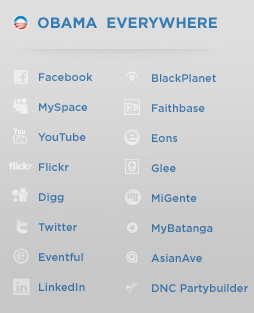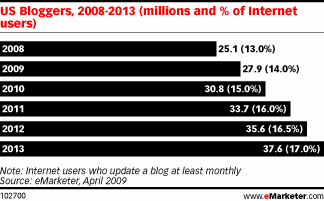Latest News
Eye-Fi Adds Video Upload Support For Photobucket, SmugMug, Picasa
May 6th, 2009 | By Elisabeth Lewin | Category: Video  Wireless memory card maker Eye-Fi yesterday announced that it is extending support for users’ video uploads to popular online photo-and video-sharing sites Picasa Web Albums, Photobucket, and SmugMug.
Wireless memory card maker Eye-Fi yesterday announced that it is extending support for users’ video uploads to popular online photo-and video-sharing sites Picasa Web Albums, Photobucket, and SmugMug.
Eye-Fi’s patent-pending technology works with Wi-Fi networks to automatically send photos and videos from a digital camera to online, in-home and retail destinations.
Users of the 4GB Eye-Fi Share Video and Eye-Fi Explore Video cards can upload videos and photos automatically, wirelessly, and directly to their albums on those sites, as well as over twenty other photo and video sharing sites.
“Many of our users were already automatically uploading their photos to Picasa Web Albums with their Eye-Fi cards and now can upload videos just as effortlessly, directly to their albums,†said Brian Axe, director of product management at Google, parent company of Picasa.
The Eye-Fi Explore Video card automatically geotags photos and videos with information about the location where the picture or video was taken. The card also and offers hotspot access from more than 10,000 Wayport and open hotspot locations in the U.S., when users are uploading content away from home.
Eye-Fi’s newest wireless SD memory cards are now available (at Apple and Best Buy stores, among others) nationwide for $79 (4GB Eye-Fi Share Video) and $99 (4GB Eye-Fi Explore Video).
First Podcasting, Now…….PenCasting?
May 6th, 2009 | By James Lewin | Category: Podcasting, Podcasting Hardware, Podcasting Software, VideoLivescribe, creators of the Pulse smartpen, have announced a tool that turns your handwritten notes and audio recordings into Flash videos, called “pencasts,†that you can embed within any Web site or blog.
Publishing multimedia from your smartpen is a bizarre application of some bizarre technology, but it’s also some geeky ubiquitous computing fun!
Here’s an example pencast:
 The Pulse smartpen is sort of a pen on steroids. The base version is $150, has 1GB of memory and can record 100 hours of audio. It comes with a recording headset, a USB dock and software to let you sync your audio and pencasts with your computer.
The Pulse smartpen is sort of a pen on steroids. The base version is $150, has 1GB of memory and can record 100 hours of audio. It comes with a recording headset, a USB dock and software to let you sync your audio and pencasts with your computer.
Pencasts are interactive Flash videos of handwritten notes and audio captured by the Pulse smartpen. To embed a pencast, individuals simply find a pencast on their My Livescribe page or the Livescribe Community, click “Embed this file†and then copy and paste the HTML into a Web site or blog.
Livescribe provides each Pulse smartpen user 250MB of free online storage to share pencasts either publicly or privately. In addition to embedding pencasts on Web sites or posting them on the Livescribe Community, individuals can share pencasts directly on Facebook (click here to see example), save their notes as a PDF file or export their recordings into an audio file.
Is there a future for smartpens and pencasting? Leave a comment with your thoughts!
Novelist Seth Harwood Gets A Book Deal With Help Of Podcasting Community
May 5th, 2009 | By Elisabeth Lewin | Category: Audio Podcasting, Making Money with Podcasts, The New Media Update
Audio podcaster and novelist Seth Harwood is pulling out all the stops, celebrating today.
No, not the typical americanized Cinco de Mayo revelry. Today commemorates the publication of Harwood’s crime novel, Jack Wakes Up, by Random House.
This is his first novel to be published by a major publishing house, but Harwood is no stranger to publishing. He has been serializing his novels, and sharing them, via podcast, with his readers.
While Jack Wakes Up is the first traditionally-published installment of Harwood’s Jack Palms series, Harwood has actually written and published as a podcast three Jack Palms books, the latest being a “prequel” story.
We tracked down Harwood earlier this week, to talk about today’s book release, and about the role that podcasting played in his current success.
Elisabeth McLaury Lewin: You have a lot of pieces of fiction to your name. Have you always been a writer?
Seth Harwood: Strangely enough, no. I was an economics major. I didn’t really get into English and literature and writing until my last year or two of school. After school, I worked in New York in commodities trading.
Elisabeth McLaury Lewin: So how did you get from dealing in commodities to writing crime fiction?
Seth Harwood: While I was in New York, I started writing more – working on a novel. Once I had a habit of writing on a regular basis, I was pretty hooked. After 15 months, I quit my commodities exchange job to focus more exclusively on writing my novel. [Laughs] I did three years of temp jobs and writing, submitting my work to journals, trying to get my writing in front of agents — all with no luck.
Eventually, I moved back to Cambridge (Mass.) and got into some continuing education creative writing workshops at Emerson and through Harvard Extension. I had to read great short stories (Carver, Richard Ford, Flannery O’Connor). The students in those classes were terriffic. I spent two years in Boston working on writing, then got into grad school at the Iowa Writers’ Workshop.
Elisabeth McLaury Lewin: Literary short stories are a pretty far cry from crime novels. How’d that happen?
Seth Harwood: [Laughs again] I moved to California.
Elisabeth McLaury Lewin: How do you mean?
Seth Harwood: I moved to California in 2005, got married, taught part time, and wrote the rest of the time. I tried to write a crime novel. I drew from all the movies, the games and the novels I liked. I threw out the formal literary influences I’d used in my previous writing. Had a great time writing it – and suddenly agents were interested in it.
My writing got better, because I was having a better time writing the stuff.
So, finally, I had these two agents were kind of interested in working with me, but somehow they weren’t quite sure. I worked with them for about 5 months. We went round and round, and then, all of a sudden, it was like they both just backed out, disappeared. Man, I was so frustrated – after all that, to have to go back to square one. I wondered whether there was something else I could do with the book?
Elisabeth McLaury Lewin: So how did you figure it out?
Seth Harwood: Around that time, I had published a short story online, and got great feedback and felt successful about that. I thought about doing a novel online, but I thought the audience might not do as well with it as an electronic text-based book. When I was teaching back in Boston, I always had liked books on tape while commuting. All these pieces kind of came together.
What cinched it was, a friend in Boston was a huge fan of Scott Sigler and his science-based horror podcast novels. My buddy told me about Sigler, and it just clicked. I decided podcasting would be a great way to get my writing out to an audience.
My friend, the big Sigler fan friend emailed him – Scott has always been very available to his readers and his listeners, and in return, they are crazy about him. And Scott was just incredible about getting me going. He helped me set up my podcast, showed me how to do everything via iChat. He listened to my early episodes, helped me figure out levels and editing and all of that.
Oh, and I’ve just got to be sure to mention – Podiobooks.com also was instrumental in helping me get going with my book podcasts. Evo and those guys do so much to help writers, and to get our work into listener’s hands.
Read more »
The iTie Stays In Perfect Position….And Features A Concealed Pocket!!!!
May 4th, 2009 | By James Lewin | Category: iPod Accessories
Yep – the iTie is the only necktie in the world that stays in perfect position….and features a concealed pocket!!!!
And this is is the only ad that purports to give a tie two (2) thumbs up…..and then gives it four (4) thumbs up!
Talk about underpromising and overdelivering! That’s twice as many thumbs up as you expected!!!!
YouTube Wants Their Cut. Or Else.
May 4th, 2009 | By Elisabeth Lewin | Category: Making Money with Podcasts, Video  YouTube is cracking down on content creators whose “branded integration” [that is, product-placement, or promotional] deals haven’t been given the go-ahead from the video site.
YouTube is cracking down on content creators whose “branded integration” [that is, product-placement, or promotional] deals haven’t been given the go-ahead from the video site.
According to Mediaweek, “the company issued written notifications to several producers … reminding them that according to its Terms of Service, users are not to post commercial videos on YouTube without permission.”
Does this mean that YouTube could pull these producers’ videos? Well, if the video mega-site finds that the content violates its Terms of Service, they would be within their rights to do so. But, as Mediaweek points out, the issue-behind-the-issue is that Google, parent company of YouTube, needs to do everything it can to wring a profit from content played on the site.
If content creators are forging agreements of their own with advertisers, Google/YouTube isn’t getting a cut of the ad revenues.
A recent estimate indicated that, although YouTube gets the lion’s share of the online video watching audience (in the neighborhood of 40 percent), the company is hemorrhaging money. The sheer magnitude of storing and serving so many millions of videos costs the company upwards of a million dollars a day. You can see how they might want to squeeze additional revenue from any resource they can.
On the other hand, YouTube has to tread carefully with their “warnings,” so as not to anger or alienate the video producers that create the content that drives the viewer attention to their site.
I asked some video series producers today about how YouTube’s crackdown on branded integration would affect him. One, who asked to remain anonymous (lest he suffer recriminations) said:
“Errrrgh. How can I say anything? I can’t really comment about it – it would violate my Terms of Service if I were to even talk about it. I can’t talk about lack of sales tools or handicaps I face…
In general terms, YouTube is in the habit of asking people to do things, but not providing them with the tools to do it.
They might ask,
‘Hey, wouldn’t it be great if you sold some inventory on your videos using Google Gadgets?’
And I’d say, ‘Sure, but do you have any sales materials I can use?’
And they’ll say, ‘Um, no.’
‘Can I create some?’
‘Um, no.’ ‘
Any ideas on how I can….?’
‘No. Sign this NDA [non-disclosure agreement].’But you can’t not put your video on YouTube if you want viewers to see it. You have to go with the flow, and see what happens –Â and make money if you can.”
Tim Street, creator of the “French Maid TV” how-to video series [pictured, above], which is produced with particular corporate sponsors in mind, had a more sympathetic view of YouTube’s predicament. They are in the business to make a profit, but, he said,
“YouTube is not making money, because they are giving it all away for free.
They may have the biggest audience for online video viewing, but free doesn’t pay the bills. Think of it this way: if you had the biggest, most popular hotel, with the highest occupancy rate anywhere, but you gave out rooms for free, how would you make any money? If you didn’t have room service of your own, but let Domino’s deliver pizza to guests’ rooms, how would you make any money?
There’s plenty of money to be made with online video. YouTube is still ironing out the details on that.”
Mass Adoption Of Web-To-TV Technology Coming by 2013
May 4th, 2009 | By James Lewin | Category: Featured Story, Internet TV, Video  Young adults have already adopted Web-to-TV video capability, and mass adoption is coming by 2013, according to market research firm In-Stat.
Young adults have already adopted Web-to-TV video capability, and mass adoption is coming by 2013, according to market research firm In-Stat.
“Once Web-to-TV video becomes simple and convenient, mass consumer adoption will follow quite rapidly,†says Keith Nissen, In-Stat analyst. “Users want a variety of their consumer devices to enable a web-to-TV video experience.â€
Highlights of their research:
- Over 40% of young adult US households view Internet video on the TV at least once per month.
- Revenue from Web-to-TV streaming services will grow to $2.9 billion in 2013.
- Within five years, the number of US broadband households viewing Web-to-TV content will grow to 24 million.
- Already, 29% of US 25 to 34 year olds with game consoles use the devices to watch streaming video off the Internet.
- In five years, there will be 7.4 million US broadband households that use media center PCs for streaming Web-to-TV content.
- TV networks and pay TV operators currently view online TV as additive to pay TV services, but Web-to-TV will ultimately force a complete restructuring of today’s video services.
- Video content will be optimized for broadcast or Web-to-TV based on content type.
Do you think mass adoption of web-to-TV video will happen by 2013? If so, what will it mean for indie video producers?
Next iPhone To Offer User-Generated Video For Non-Geeks?
May 3rd, 2009 | By Elisabeth Lewin | Category: iPhone, iPods & Portable Media Players, Video  Peter Burrows at Business Week speculated earlier this week in his “Byte of the Apple” column that the next iteration of the iPhone will feature an easy-to-use video suite.
Peter Burrows at Business Week speculated earlier this week in his “Byte of the Apple” column that the next iteration of the iPhone will feature an easy-to-use video suite.
A new, updated version of the iPhone is rumored to be unveiled next month at the Apple Worldwide Developers’ Conference. Burrows says his “gut” – and also an unnamed source “familiar with Apple’s plans for the next iPhone” – that “Apple will make the iPhone a one-stop studio for recording, editing, viewing and sharing your own videos.”
He suggests that users will be able to shoot video, “Flip”-style, edit the best chunks with an iMovie iPhone app, and MMS support for sharing your user-generated movie with others. The iPhone already has a decent little screen for watching your creations.
Does it make sense for Apple to jump into cell-phone video so late in the game? Absolutely. The have a potent combination:
- a large (and growing) user base,
- a track record of applications that are straightforward and simple to operate,
- and a global interest in user-generated video (both from a creator’s and a viewer’s standpoint).
Other companies were quicker to enter the mobile video fray, but Apple has had a charmed experience with coming later to the game (with digital music downloads, with multifunction smart phones, with launching an App Store) and somehow capitalizing on a hot but maturing market. On top of this lucky track record, Apple has had a good run of introducing products (the iPod and the iPhone, the Mac, and so on) that make even the non-geek capable of creating and consuming all manner of digital content.
Of course, the promise of an iPhone video is still rumor, the business press version of “my cousin’s boss’ stepsister gave me the inside scoop.” But this rumor is tantalizing enough that we are willing to suspend our skepticism for a month, and eagerly await the (rumored) announcement of a new version of the iPhone next month.
Disney Partners With Hulu: The Web Video Eyeball War of 09 Begins
May 2nd, 2009 | By Elisabeth Lewin | Category: Internet TV, The New Media Update, Video  Thursday, entertainment empire Disney fired a loud salvo in the struggle to unseat YouTube as the king of online video. Disney, parent company of TV network ABC, announced an agreement to join forces with free online video service Hulu.com.
Thursday, entertainment empire Disney fired a loud salvo in the struggle to unseat YouTube as the king of online video. Disney, parent company of TV network ABC, announced an agreement to join forces with free online video service Hulu.com.
Disney will join Hulu’s other content partners, NBC Universal, and News Corporation, as well as Providence Equity Partners as a joint venture partner.
This new partnership between is a smart step for Disney and for Hulu. Hulu gets access to both current popular ABC and Disney shows as well as classic Disney family fare. Disney (and ABC) can serve up ad-supported streams of their content, on a site that allows its users to set up subscriptions and a viewing queue. [We hope and pray that the Hulu player will take up the old ABC player’s HD capabilities, but lose the really annoying “click to continue” interruptive advertising model.]
What we are most curious to see working out, is how and whether Hulu will take on YouTube for a larger share of the online video-audience pie. The pie itself is growing: comScore found that U.S. Internet users viewed 14.5 billion online videos during the month of March, a jump of 11 percent over February 2009.
comScore also reported that Hulu broke into the Top 3 sites with the most videos viewed during March as well, and its users watched for a longer duration than users of other top online video sites. However, Google’s YouTube far outstripped its nearest competitors (mySpace, Yahoo! and Hulu), gobbling up 40.9 percent online video market share (compared to Hulu’s eensy 2.6 percent).
If the content on Hulu is more desirable, and the interface is more attractive and easier to use than at YouTube, perhaps viewers will eventually turn their attention there. But Hulu will have to do more than that to lure a larger share of the online video audience. YouTube has been scrambling in recent weeks to improve the site, becoming more “social,” with Twitter updates and social networking features, along with functionality improvements like easier uploads from mobile devices and an educational video hub.
Will Hulu (and its content partners) have the stamina and budget to challenge YouTube?
Details of the Disney-ABC/Hulu partnership after the break.
Read more »
WhiteHouse 2.0: The Future Of Propaganda?
May 2nd, 2009 | By James Lewin | Category: Audio Podcasting, Commentary, Internet TV, New Media Organizations, Podcasting, Streaming Video, Video  President Barack Obama is turning the White House into a leading example of how organizations can use Internet media and social networking.
President Barack Obama is turning the White House into a leading example of how organizations can use Internet media and social networking.
In a post at the official White House Blog, The White House called its approach to the Internet WhiteHouse 2.0, noting its extensive new media and social media presence.
According to The White House, “WhiteHouse.gov is an important part of the Administration’s effort to use the internet to reach the public quickly and effectively – but it isn’t the only place.”
You can now find the White House all over the Web:
- Facebook.com/WhiteHouse
- MySpace.com/WhiteHouse
- Twitter.com/WhiteHouse
- Flickr.com/WhiteHouse
- Vimeo.com/WhiteHouse
- YouTube.com/WhiteHouse
- iTunes (videos & podcasts)
The White House is now creating and releasing an unprecedented amount of media.
Open Government, Or Propaganda?
Regardless of your political stripes, though, WhiteHouse 2.0 has to be seen, at least to some degree, as propaganda.
 We’ve looked previously at how Obama used new media and social media to win the presidential election. A key part of his win was that he made sure that he had content everywhere, so that his team controlled his message.
We’ve looked previously at how Obama used new media and social media to win the presidential election. A key part of his win was that he made sure that he had content everywhere, so that his team controlled his message.
McCain failed to do that, leaving a vacuum on the Internet. This meant that, instead of voters seeing pictures and videos that painted McCain and his campaign in a positive light, they found things like Sarah Palin’s interview fiasco.
If you take a look at The Official White House Photostream, you’ll see that, not only is The White House opening up an amazing collection of candid photographs, but that the images are cherry picked to put the administration in a positive light.
Some of the images are even grouped into a set with the propaganda-speak title Delivering On Change, It offers hundreds of beautiful photos of Obama and his team in action – in meetings, giving speaches, calling world leaders, flying on Air Force One – delivering on change.
Here are Barack and Michelle rolling up their sleeves, digging in the dirt, planting a tree and delivering on change:
Take a look at The White House presence on YouTube or iTunes, and you’ll see WhiteHouse 2.0 delivering a consistently open and positive media blitz.
WhiteHouse 2.0 is delivering on change – a change to George W. Bush’s approach to new media.
Do a Google image search for George Bush, and you’ll see what happens when you leave a media vacuum on the Internet:
The results are dominated by unflattering photos of Bush eating a kitten, flipping you the bird and just looking goofy.
WhiteHouse 2.0 Presents A Challenge To Content Creators
The new media blitz of Obama’s WhiteHouse 2.0 presents a challenge to bloggers, podcasters and vloggers.
Obama is serving up an unprecedented volume of new media. He’s putting it all over the Internet, making it easy to find. And he’s licensing it with the most liberal terms he can, making it easy to use, remix and mashup.
This puts indie new media publishers on similar footing as traditional media publishers. If you want to publish about Obama’s White House, you’ve got your choice of great photos, video and audio.
Great photos, video and audio that make President Obama and his administration look and sound good.
WhiteHouse 2.0 is the most powerful new media organization in the world.
What do indie content publishers have to do to avoid becoming part of the White House’s propaganda machine, like mainstream media did during much of George W. Bush’s presidency?
eMarketer: ‘Blogs Are Now Mainstream Media’
May 1st, 2009 | By Elisabeth Lewin | Category: Citizen Media, The New Media UpdateOnline marketing research firm eMarketer released its latest report Wednesday, a study that indicates a growing number of Americans Internet users are publishing their own blogs, for a growing blog-reading audience.
The cloyingly named The Blogosphere: A-Twitter with Activity, report indicates that the number of American Internet users making their own blogs is growing: 27.9 million US Internet users have a blog (updated at least once per month), accounting for 14% of the Internet population. By 2013, the study predicts a blogging population of 37.6 million (or a projected 17% of the Internet population).
More interesting to bloggers, podcasters, and other media creators, is the study’s analysis of the growing number of blog readers.
eMarketer estimates that in 2009, 96.6 million US Internet users will be reading blogs (using their threshhold of “at least once per month”). By 2013, the study predicts that 128.2 million people, or 58% of all US users, will be reading blogs.
“Blog sites now touch tens of millions of people in the US, and the numbers of blog readers and creators are projected to continue growing,†says the study’s author, Paul Verna.
“Blogs are now mainstream media,†said Richard Jalichandra, CEO of Technorati. “You’re also seeing mainstream media coming in the other direction by adding blog content.â€
This point of view is echoed by David Tokheim, of blogging platform Six Apart Media. “The lines are becoming blurred between a standalone blog that might be created on TypePad or Blogger or WordPress and blog content that’s created by The New York Times.â€
Study author Verna says, “today’s [blogs] are about two-way conversations that take place on many fronts: independent, standalone blogs; social networks; e-commerce and mainstream media sites; and microblogging platforms such as Twitter….This blogging activity presents new opportunities for marketers to influence—and monitor—conversations that may be relevant to their businesses.â€
The full text of the article, and its attendant charts and graphs, will cost you $695, and is available here.


